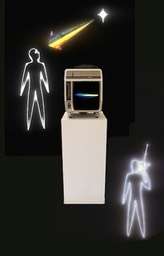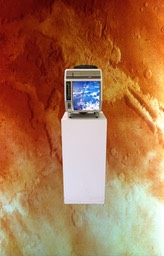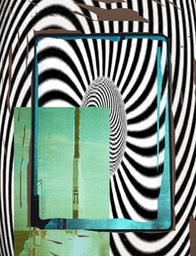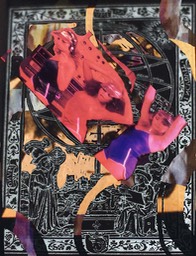When Kevin Arrow and Barron Sherer received Cannonball WaveMaker and Knight Arts Challenge grants for their project, Obsolete Media Miami (O.M.M.), it was not just to support their own collecting habits. Fellow artists and scholars would be given access to this treasure trove of VHS tapes, audio cassettes, vinyl, laser disks, commercial filmstrips – and more slides then you can shake a selfie stick at. Colleagues Juan González and Daniel Clapp, who both work at the de la Cruz Collection, welcomed the chance to avail themselves of the materials and expertise that Arrow and Sherer eagerly share. Musicians and visual artists who grew up in Miami, both absorbed, resisted and participated in the various musical genres that have shaken and stirred the Magic City in recent decades. They avidly incorporated elements of O.M.M.’s visual archive, while recording their own soundtrack to create “Document 2” in the form of a zine. Their backgrounds and current practice provided a natural fit for the project.
“Growing up, it started off with metal – listening to Maiden, Metallica and stuff like that,” Gonzalez recalled. Meanwhile, his mom would play the Miami Sound Machine in the car during school commutes, which he would try to drown out with headphones. “Then, you grow up a little,” he continued, “and you listen to Prince and Sly.” As for playing himself, he always pursued “the abstract – the noisier, the crazier, the better.”
King Crimson was an early favorite of Clapp, whose dad had a large and diverse collection. “It seemed so ahead of its time and it stood out to me from the rest of the music.” A young and progressive aunt then turned him on to Public Enemy and N.W.A. “She was also really into Pink Floyd, of course, in her teens,” he added. Miami Bass was a strong influence. “You get in the car, you hear Miami Bass; you’re walking on the street and you hear other cars playing Miami Bass. It was something from here, and… it will always sound like home to me.”
Both majored in visual arts during college and gradually came to infuse their music with visual elements and vice versa. The next round of influences included Kraftwerk, Cluster, Moebius, Suicide, The Cure, John Carpenter, Jan Hammer – “the Led Zepplins of their genre,” added Gonzalez. Sonic Youth was another favorite.
González transitioned from performing in and around sculptural installations (with Carlos Ascurra as “Viking Funeral”) to “wiring” sculptural installations that can reliably auto-play with just the toggling of a switch. Clapp’s photo practice that dates back to high school has evolved to include video works that naturally combine visual and sound components.
Gonzalez and Clapp have an intermittent 16-year history together, though not working exclusively as an ensemble. For the past year and four months, they’ve gone by the quasi-palindrome band name Das SaD, performing at Sweat Records, at Churchill’s Pub, in backyards and garages, but also in art galleries. “Often, we don’t have to talk about things together at this point. The communication is almost telepathic.” They use traditional guitar-bass-drums, but also have collected an eclectic electronic rig with vintage drum machines, keyboards, synthesizers, mixers, delays. “I think we try to allow the machines to do what they do well, to stay out of their way… kind of shepherd them into something that makes sense to us,” said Clapp. González calls the work “sound installation and noise performance.”
Das SaD’s vintage electronics and eclectic approach connect them intuitively and practically to O.M.M., whose collection also includes the recording and projection devices that allow display of the media. Clapp’s photo collages feature a classic Kodak Telex slide viewer/projector. González said, “I knew that they were going to have science, so then I also looked for more music-related images. The goal for his pages was “me in O.M.M.” Although Clapp visited the archive repeatedly and considered alternative themes, it was the first group of space-related slides that he eventually layered in and behind the tabletop projector. “Not exactly nostalgia, but celebrating the retro-future that the four of us of us enjoy,” he said.
Both artists have produced zines before, and the recent Zine Fest Miami provided an opportune release venue and appreciative audience for their official 16-page O.M.M. “Document 2” (the first being a collaboration between David Brieske and Richard Vergez). Sad DaS’ project combines their photo-collage imagery with a 19-minute set of music loosely programmed to listen to while paging through the zine.
“It’s a great time now,” said Gonzalez. “You can use analog and mix it with digital; it doesn’t really matter, as long as it gets done.” Concluded Clapp, “Everything eventually goes into a computer; whatever makes sense, whatever is going to work.”



